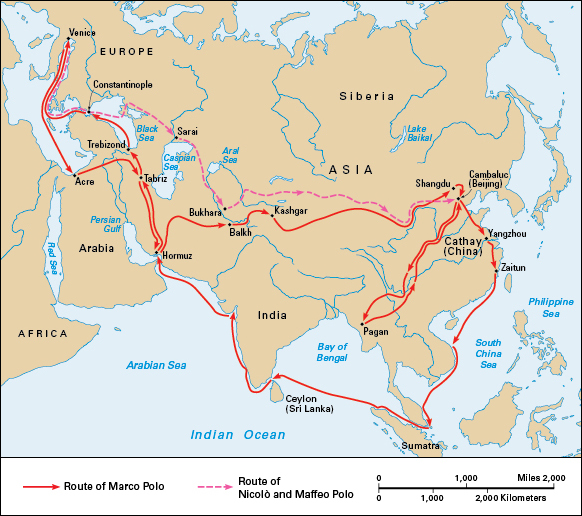Polo, Marco (1254-1324?), a Venetian trader and traveler, became famous for his journeys in central Asia and China. Although he was not the first European to reach China, he wrote a book that introduced many Europeans to the country. China was then called Cathay and considered an exotic land.
Early life.
Marco Polo was born in Venice. His father, Nicolo Polo, was a merchant. Nicolo and his brother Maffeo Polo had left on a trading mission shortly before Marco’s birth. Marco’s mother died when he was young, and an aunt and uncle raised him. They trained him to be a merchant. Besides reading, writing, and arithmetic, Marco learned about using foreign money, judging products, and handling cargo ships.
Marco’s father and uncle remained abroad for many years. During the 1250’s, they went to Constantinople (now Istanbul, Turkey), to conduct trade between Europeans and Arabs and Asians. In 1260, the Polo brothers decided to make a trading expedition to central Asia. When the outbreak of wars blocked their route home, they decided to travel further east. After a long and difficult journey, they reached China. They met the Mongol ruler Kublai Khan, who welcomed them and wanted to know more about Europeans and Christianity.
The Polo brothers returned to Venice in 1269. But the Khan had invited them to visit China again. They soon left Venice, taking 17-year-old Marco with them.
Journey to China.
In 1271, the Polos crossed the Mediterranean Sea to the Palestinian port of Acre (now Akko, Israel). From there, they went to the Persian Gulf, probably by camel caravan. They escaped a raid on their caravan and continued to the port of Hormuz in Persia (now Iran). Failing to find adequate ships for their long journey ahead, they continued overland across Asia.

The Polos struggled through the Pamirs, a mountainous region mostly in what is now Tajikistan, and crossed the barren Gobi Desert. After more than three years, the Polos reached Kublai Khan’s splendid summer palace in Shangdu, near what is now Zhangjiakou, China.
Marco was in his early 20’s when he met Kublai Khan, who was about 60. Marco was amazed by the luxurious world of the Mongols. Marco knew four languages, and the Khan sent him on many official tours of the kingdom. These tours took Marco to China’s southern and eastern provinces and possibly into parts of Southeast Asia and India. Marco served as a government official in the Chinese city of Yangzhou for three years.
As time passed, the Polos began to worry about returning home safely. They believed that if Kublai Khan were to die, the Khan’s enemies might seize them. Finally, in 1292, their opportunity came. The Khan asked the Polos to escort a young princess to his great-nephew Arghun, the Mongol ruler of Persia, as a bride. The Polos and a fleet of 14 junks sailed from Zaitun (now Quanzhou) in southern China.
The fleet sailed to what is now Singapore. From there, it traveled north of Sumatra and then around the southern tip of India. The Polos crossed the Arabian Sea to Hormuz. While they were traveling, Kublai Khan died. They left the wedding party and traveled overland to the Turkish port of Trebizond (now Trabzon). They sailed to Constantinople and from there to Venice, arriving in 1295. Their journey to China and back probably totaled nearly 15,000 miles (24,100 kilometers). The men had been gone for 24 years.
Later life.
The Polos returned from China with many riches. Kublai Khan had given them ivory, jade, jewels, porcelain, silk, and other treasures. When they arrived in Venice, the city was at war with Genoa, its long-time rival. The Genoese captured and jailed Marco Polo. Historians do not know the details of his capture. In prison, Polo decided to share his travels. Aided by his notes, he told the story to a popular writer, Rustichello of Pisa, a fellow prisoner. Rustichello translated Polo’s words into Old French, the standard written language of Italy at the time. The book, called The Description of the World, was completed in 1298. Later editions were called The Book of Marvels and The Travels of Marco Polo.
In his book, Polo told about Kublai Khan’s rich, advanced empire. He described the Khan’s postal system, which consisted of a vast network of courier stations. Riders on horseback relayed messages from one station to another. Polo commented on many Chinese customs, such as the mining and use of coal as fuel. Coal had not yet been used in Europe. Polo called coal black stones. He also marveled at the Chinese use of paper money, made of mulberry bark, which bore the seal of the emperor. At that time, Europeans traded with silver, gold, copper, and lead coins.
Printing had not yet been invented in Europe, and so scholars copied Polo’s book by hand. The Description of the World was widely read in Europe and may have influenced many explorers. The Italian navigator Christopher Columbus probably used it to estimate the distance between Spain and Asia. It also stimulated European interest in Asia and helped bring to Europe such Chinese inventions as papermaking and printing. Genoa and Venice made peace in 1299. Polo was freed and returned to trading. He died about five years later in Venice.
